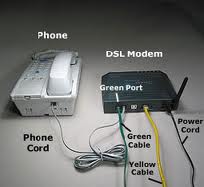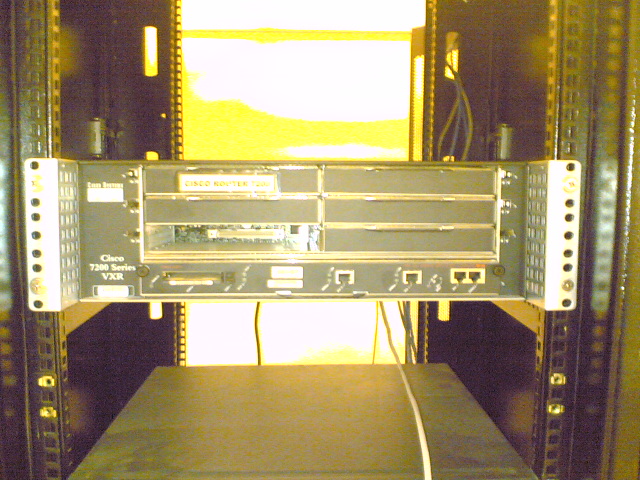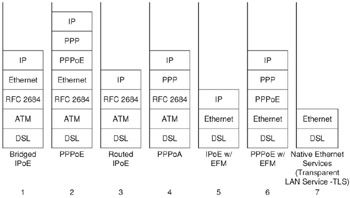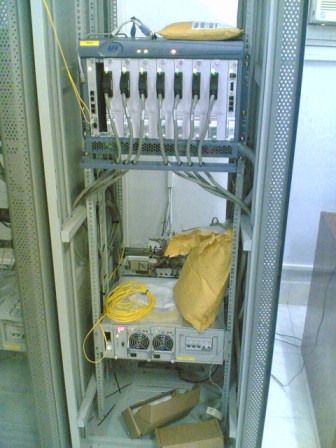





Digital Subscriber Line
DSL (Digital Subscriber Line) is a technology for bringing high- bandwidth information to homes and small businesses over ordinary copper telephone lines. xDSL refers to different variations of DSL, such as ADSL, HDSL, and RADSL. Assuming your home or small business is close enough to a telephone company central office that offers DSL service, you may be able to receive data at rates up to 6.1 megabits (millions of bits) per second (of a theoretical 8.448 megabits per second), enabling continuous transmission of motion video, audio, and even 3-D effects. More typically, individual connections will provide from 1.544 Mbps to 512 Kbps downstream and about 128 Kbps upstream. A DSL line can carry both data and voice signals and the data part of the line is continuously connected. DSL installations began in 1998 and will continue at a greatly increased pace through the next decade in a number of communities in the U.S. and elsewhere. Compaq, Intel, and Microsoft working with telephone companies have developed a standard and easier-to-install form of ADSL called G.Lite that is accelerating deployment. DSL is expected to replace ISDN in many areas and to compete with the cable modem in bringing multimedia and 3-D to homes and small businesses.
DSL Network Architecture



.jpg)
_L[c1e9f14fbaa04bea15e3c7dabf18e95a].jpg)
.jpg)
DSL Modem placed at Homes & Offices location
DSLAM placed at indoor & outdoor Network access location
cisco 3650 switch
Cisco 7200 series router used for BRAS functionality
AAA server
Devices placed at Network core location
.jpg)
Downlink
Uplink
Possible Media Types:

.jpg)
Copper cable
Fiber cable
Wireless link

Possible Technologies used on physical layer

Possible combinations protocols layer digram used for downlink

.jpg)
Media type Used mostly:
Fiber cable
Layer 2&3 Technology used normaly:
ATM & Ethernet
All DSL Modems or router must be connected to DSLAM
All DSLAM must be connected to BRAS
Technology used mostly for aplication layer is Radius
Router Connected to internet
BRAS must be connected to AAA server
DSLAM (Digital Subscriber Line Access Multiplexer)
A DSLAM (Digital Subscriber Line Access Multiplexer) is a network device, usually at a telephone company central office, that receives signals from multiple customer Digital Subscriber Line (DSL) connections and puts the signals on a high-speed backbone line using multiplexing techniques. Depending on the product, DSLAM multiplexers connect DSL lines with some combination of asynchronous transfer mode (ATM), frame relay, or Internet Protocol networks. DSLAM enables a phone company to offer business or homes users the fastest phone line technology (DSL) with the fastest backbone network technology (ATM). There are two type of DSLAM in the market (ATM DSLAM & IP DSLAM).
Broadband Remote Access Server (B-RAS)
A broadband remote access server routes traffic to and from broadband remote access devices, including DSL access multiplexers and the ISP's network. The key benefits of using broadband remote access servers are:
They provide a single point for change control
B-RAS is a common, access-agnostic operational model
It is multiservice access node (MSAN) independent
If network changes are required, itís better to make changes at a single B-RAS server than at dozens of devices.
AAA server (authentication, authorization, and accounting)
An AAA server is a server program that handles user requests for access to computer resources and, for an enterprise, provides authentication, authorization, and accounting (AAA) services. The AAA server typically interacts with network access and gateway servers and with databases and directories containing user information. The current standard by which devices or applications communicate with an AAA server is the Remote Authentication Dial-In User Service (RADIUS).








